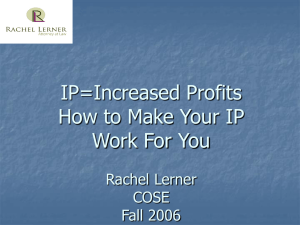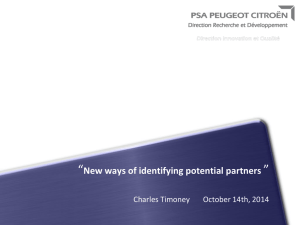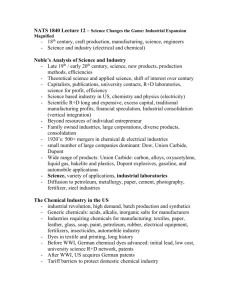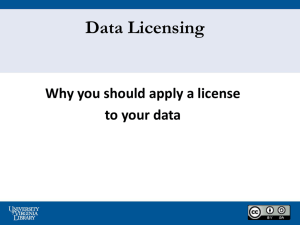Protocol for defining and capturing DNA patents
advertisement
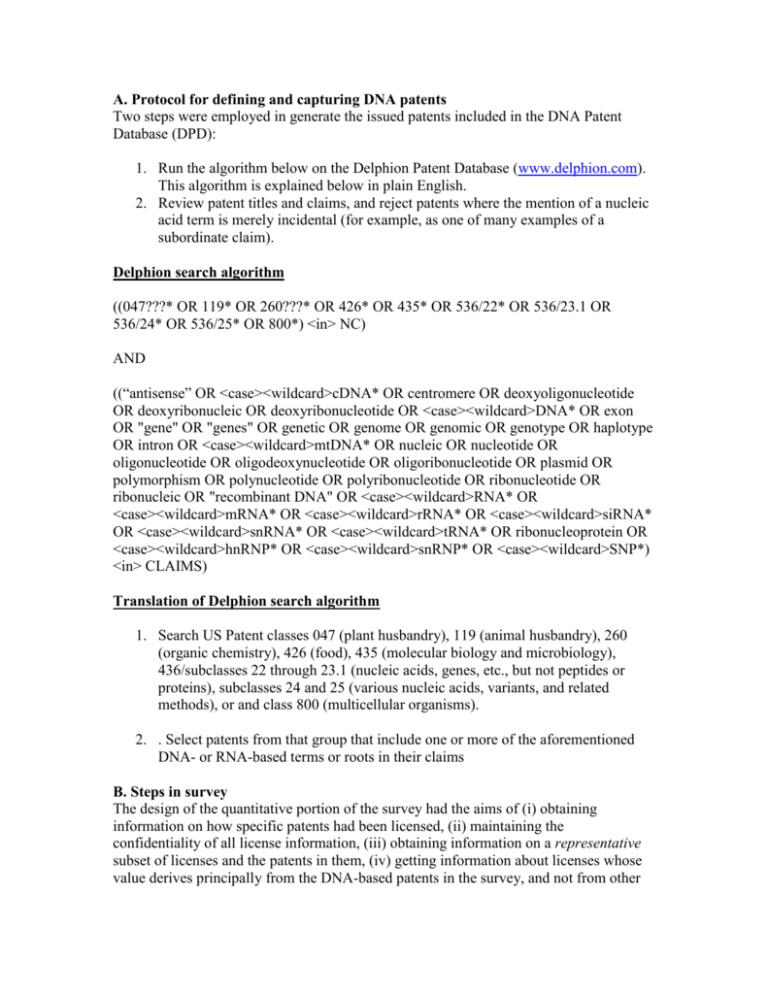
A. Protocol for defining and capturing DNA patents Two steps were employed in generate the issued patents included in the DNA Patent Database (DPD): 1. Run the algorithm below on the Delphion Patent Database (www.delphion.com). This algorithm is explained below in plain English. 2. Review patent titles and claims, and reject patents where the mention of a nucleic acid term is merely incidental (for example, as one of many examples of a subordinate claim). Delphion search algorithm ((047???* OR 119* OR 260???* OR 426* OR 435* OR 536/22* OR 536/23.1 OR 536/24* OR 536/25* OR 800*) <in> NC) AND ((“antisense” OR <case><wildcard>cDNA* OR centromere OR deoxyoligonucleotide OR deoxyribonucleic OR deoxyribonucleotide OR <case><wildcard>DNA* OR exon OR "gene" OR "genes" OR genetic OR genome OR genomic OR genotype OR haplotype OR intron OR <case><wildcard>mtDNA* OR nucleic OR nucleotide OR oligonucleotide OR oligodeoxynucleotide OR oligoribonucleotide OR plasmid OR polymorphism OR polynucleotide OR polyribonucleotide OR ribonucleotide OR ribonucleic OR "recombinant DNA" OR <case><wildcard>RNA* OR <case><wildcard>mRNA* OR <case><wildcard>rRNA* OR <case><wildcard>siRNA* OR <case><wildcard>snRNA* OR <case><wildcard>tRNA* OR ribonucleoprotein OR <case><wildcard>hnRNP* OR <case><wildcard>snRNP* OR <case><wildcard>SNP*) <in> CLAIMS) Translation of Delphion search algorithm 1. Search US Patent classes 047 (plant husbandry), 119 (animal husbandry), 260 (organic chemistry), 426 (food), 435 (molecular biology and microbiology), 436/subclasses 22 through 23.1 (nucleic acids, genes, etc., but not peptides or proteins), subclasses 24 and 25 (various nucleic acids, variants, and related methods), or and class 800 (multicellular organisms). 2. . Select patents from that group that include one or more of the aforementioned DNA- or RNA-based terms or roots in their claims B. Steps in survey The design of the quantitative portion of the survey had the aims of (i) obtaining information on how specific patents had been licensed, (ii) maintaining the confidentiality of all license information, (iii) obtaining information on a representative subset of licenses and the patents in them, (iv) getting information about licenses whose value derives principally from the DNA-based patents in the survey, and not from other intellectual property not in this survey, and (v) getting responses from as many licensing offices as possible. The survey design can best be understood by working backward from the goals described. Managers of large university licensing offices suggested they would be willing to submit license information on a maximum of 12 license agreements (step 10 in the flow chart). Thus a computer algorithm was developed to select 12 representative licenses, without burdening the respondent with providing a large amount of data on all their agreements. Since patent issue dates are public, it was decided to use the issue date of the oldest patent in the licensei as a “virtual” license date, from which a representative subset would be selected. The algorithm for selecting a representative subset was simplythat licenses were ordered by virtual license date, divided into 12 equal sections, and one license was selected at random from each section. Thus, it was necessary to ask respondents to “bundle” their patents into licensing agreements, or to create a many-to-many relational database showing which patents are included in which licenses (step 9). (There is frequently more than one patent in a license, and frequently patents are licensed more than once). The “bundling” data are the only data given by respondents for their entire patent set. Consistent with goal (iv) above, licenses confounded by the presence in them of intellectual property not in the survey, the value of which was deemed to confer most of the value of the license, were identified by the first pair of questions in the Main Questionnaire, and respondents were asked not to continue providing information about them. To simplify the “bundling” operation, respondents were given the option of answering a modified version of the questionnaire for patents that had been licensed more than 10 times, such as Cohen-Boyer and Axel patents (sections 7 and 8). For these broadly licensed patents, the questionnaire is about the entire set of licenses, not about an individual license. To further simplify the license “bundling” operation, respondents were asked to identify those patents that had never been licensed (step 5). At the request of the Advisory Board, a question was added asking why respondents elected to pay maintenance fees on three of their patents, identified in step 5, that had never been licensed (step 6). Patents frequently have more than one owner. The list of patents about which respondents were surveyed was generated from the “assignee”, or owner field in Delphion, and could thus be sent to any of the co-assignees. Only one owner typically manages, and has the ability to grant licenses, to the patent. The survey thus gave respondents the option of indicating that they were not the co-assignee managing a certain patent (steps 3 and 4). Two fully computerized schools were able to complete the questionnaire in one day using our web interface, and others took weeks of afternoons or evenings. One of the largest schools was able to efficiently provide much of the data directly from its relational database, bypassing the web interface entirely. The Central Office of the University of California, as well as the Berkeley, Los Angeles, San Diego, and San Francisco offices answered the policy portion of the questionnaire by telephone. Comments were transcribed, and submitted to the interviewees for approval. Others regretfully declined to respond, reporting that their computer systems and administrative infrastructure were not up to the task. C. Survey instrument The text of the survey instrument is provided below: Microsoft Word File Description of Web Based Survey of DNABased Patents 5/2/03. Provided as a convenience only. To log on to the website, go to http://www.weown.net/dnasurvey, select your institution from the drop down menu, and use the password which was given to you. This survey is based on applying an algorithm developed to identify a group of DNA based patents within the set of issued U.S. patents the Delphion search engine identifies as being assigned to your institution since 1971. A description of the algorithm used to identify DNA-based patents can be found on http://dnapatents.georgetown.edu/ If you have questions about the Instructions & Definitions, or the survey website, contact Lori Pressman at lori@loripressman.com Note: CAPITALIZED W ORDS in the questions are defined in INSTRUCTIONS AND DEFINITIONS. The Survey has been divided into 10 steps, summarized here: 1. Read Instructions and Definitions (Transmitted separately) 2. Complete Basic Information and Policy Questions 3. Select patents that are not managed by your institution 4. Enter which institution is managing the patents selected in #3. 5. Select Never Licensed patents 6. Describe why your institution elected to pay maintenance fees on 3 Never Licensed Patents 7. Select patents with more than 10 licenses 8. Complete questionnaire for patents selected in #7 above 9 Associate remaining patents with licenses 10 Complete questionnaire for 12 licenses Step 2. Basic Information: (The following should reflect the appropriate individual to be contacted should clarification of the survey results be required:) Name: ___________________________________________________________ ____________ Office: ___________________________________________________________ ____________ Title: ___________________________________________________________ ____________ Street: ___________________________________________________________ ____________ ___________________________________________________________ ____________ City State Zipcode ___________________________________________________________ ____________ Phone # E-mail address FAX # 1. Name of Institution: __________________________________________________________ 2. Fiscal Year 2001 for your institution covers the period __________2000 to __________2001. Step 2 Continued: Policy and Philosophy:: Please provide, if available, references, electronic, or paper, as appropriate, which document i) your institution's policy regarding the patenting and licensing of DNA-based patents (see Definitions) and research tools (either define yourself in part h below, or note that you are working off of the NIH definition), or ii) your office's general practice or operating philosophy regarding such patents and/or research tools. Please send to waltersl@georgetown.edu, or to Professor LeRoy Walters, Kennedy Institute of Ethics Georgetown University, 37th and O Sts., NW, Washington, DC, 20057 : Confidentiality Provision for Part 1: Check Here __ if we may publish your responses to question 3 below, but without attribution. (The researchers will approach you on a case by case basis for permission to use an attributed quote.) 3. Please describe the general practice and/or operating philosophy of your office concerning the patenting and licensing of: a) DNA-BASED PATENTS as defined in the attached Definitions and Instructions. __________________________________________________________________ __________________________________________________________________ __________________________________________________________________ __________________________________________________________________ __________________________________________________________________ __________________________________________________________________ __________________________________________________________________ ______________________________ b) a fully sequenced human gene? Example: The human growth hormone gene. _____________________________________________________________________ _____________________________________________________________________ _____________________________________________________________________ _____________________________________________________________________ ____________________________________________________ __________________________________________________________________ _______________ c) a fully sequenced human gene which codes for a protein of known function. __________________________________________________________________ __________________________________________________________________ __________________________________________________________________ __________________________________________________________________ __________________________________________________________________ __________________________________________________________________ ________________________________________________________________ ________________________________________________________________ _________________________________ d) a fully sequenced human gene which codes for a protein which itself is a therapeutic drug. __________________________________________________________________ __________________________________________________________________ __________________________________________________________________ __________________________________________________________________ __________________________________________________________________ __________________________________________________________________ __________________________________________________________________ ________________________________ e) a fully sequenced human gene which codes for a protein which is a target for drug discovery. __________________________________________________________________ __________________________________________________________________ __________________________________________________________________ __________________________________________________________________ __________________________________________________________________ __________________________________________________________________ __________________________________________________________________ ________________________________ f) a partial human genetic sequence, not a fully sequenced gene, which is a marker for a phenotype. __________________________________________________________________ __________________________________________________________________ __________________________________________________________________ __________________________________________________________________ __________________________________________________________________ __________________________________________________________________ __________________________________________________________________ ________________________________ g) Please suggest useful categories of patents which claim nucleic acids sequences from a licensing policy point of view: ________________________________________________________________ ________________________________________________________________ ________________________________________________________________ ________________________________________________________________ ________________________________________________________________ ________________________________________________________________ __________________________ h) How would your office define research tool? _____________________________________________________________________ _____________________________________________________________________ _____________________________________________________________________ _____________________________________________________________________ _____________________________________________________________________ _____________________________________________________________________ _____________________________________________________________________ _______ i) Please describe the general practice and/or operating philosophy of your office concerning the licensing of Research Tools, as defined by you above. Is the practice and/or philosophy different if the tool is patented than if it is biological material only? Please comment ________________________________________________________________ ________________________________________________________________ ________________________________________________________________ ________________________________________________________________ ________________________________________________________________ ________________________________________________________________ __________________________ Step 3: Select patents that are not managed by your institution. Using the web interface, move patents from the starting box “All Patents” which are not managed by your institution to the box “not managed by your institution” Step 4: Identify the institution managing the patents selected in Step 3. Using the drop down menu on the web interface, identify the institution managing the patents selected in Step 3. Step 5: Select never licensed patents. Using the web interface, move patents which have never been licensed from the starting box “All Remaining Patents, after sorting in step 3” to the box “Never Licensed”. Step 6: Describe why your institution elected to pay maintenance fees on never licensed patents. Self explanatory. The computer selects 3 from those identified in step 5, and provides a text entry field. Step 7: Select patents with more than 10 licenses. Using the web interface, move patents to which more than 10 licenses have been granted from the starting box “All Remaining Patents, after sorting in step 3 and 5” to the box “Broadly Licensed”. Step 8: Complete questionnaire for patents selected in step 7 above: Confidentiality Provisions for Step 8: Questionnaire on Broadly Licensed Patents. These results WILL be reported in their entirety, the patent numbers, and the licensing patterns associated with them. If you do not want information reported, do not answer the questions. A2. For these patents in this license: Was the funding (please check one) Primarily U.S.Government Some U.S.Government No U.S. Government A3. Do most of these licenses contain a license to nonpatented biological material, or to other patents not in this survey ? Yes No A4. If the answer to (A3) above is “yes”, in your judgment, does the biological material and additional IP provide Most Some A Neglible amount of the value of the licensed property. A5. How many total licenses were granted to these patent(s)? ________ How many of the total were Non-Exclusive (see definitions) _________ If a substantial majority were not non-exclusive, please contact the survey administrator, as this alternate form may not be appropriate. FY First Lic in group became Active _________ FY Last Lic in group became Active _________ FY, if any, First Lic became Inactive _________, All still active FY, if any, Last Lic became Inactive _________, All still active A6. Reason that First Lic in the group to become inactive became Inactive (please check one): All the patents in the License Expired Terminated by Institution for Nonperformance Terminated by Licensee for business reasons Other , if Other, please comment _______________ A7. Reason that Last Lic in the group to become inactive became Inactive (please check one): All the patents in the License Expired Terminated by Institution for Nonperformance Terminated by Licensee for business reasons Other _______________ , if Other, please comment A8. If more detailed information is available on the numbers of licenses granted over time (e.g. 10 per year for the first 10 year of life of the patents, rising to 50 per year over the next 6, declining to 20 in the last year of patent life), please provide. A9. Types of companies which licensed the patent(s) (please review Definitions and check one). NUMBER OF START-UP’S WHICH LICENSED THE PATENT(S) _____ Web has options for NUMBER OF SMALL COMPANIES WHICH LICENSED THE PATENT(S) _____ “exactly”, “approximately” NUMBER OF LARGE COMPANIES WHICH LICENSED THE PATENTS(S) _____ and “don’t know” A10. FY, if any, there was a liquidity event regarding a START-UP LICENSEE. ________ A11. Revenue Generation [Web has option to check “not to date”] FY, if any, all Licenses to these patents generated > $1M GROSS LICENSE INCOME, cumulative _________ FY, if any, all Licenses to these patents generated >$10M GROSS LICENSE INCOME, cumulative_________ A12. Revenue Composition, for $1M < License Income Received cumulative < $10M : If the group of licenses generated License Income >$1M, what was the revenue composition of all the License Income received starting from the first $1M through and up to $10M License Income received? Mostly RUNNING ROYALTIES Mostly CASHED-IN EQUITY Mostly neither RUNNING ROYALTIES nor CASHED-IN EQUITY A13. Revenue Composition, for License Income Received > $10M, cumulative Mostly RUNNING ROYALTIES Mostly CASHED-IN EQUITY Mostly neither RUNNING ROYALTIES nor CASHED-IN EQUITY A14: Qualitative comments on your institution’s approach to diligence for this broadly nonexclusively licensed patent(s): ______________________________________________________________________ ______________________________________________________________________ ______________________________________________________________________ ______________________________________________________________________ ______________________________________________________________________ ______________________________________________________________________ _________________ A15. Diligence, consult Instructions and Definitions and check all that apply to several (at least 3 or 10%, which ever is greater) licenses in the group: [Web has three radio buttons for each question, Yes, No, Information not available] a) A default other than a financial one will result in termination of the license Y,N, NA b) A default other than a financial one will result in significant loss of rights under the licenses Y, N, NA c) The licenses have dated REQUIREMENT(S)) to raise money. Y, N, NA d) The licenses have dated REQUIREMENT(S) to spend money toward product development. Y, N, NA e) The licenses have dated REQUIREMENT(S) to submit products for FDA approval. Y, N, NA f) The licenses have dated REQUIREMENT(S) to sell product. Y, N, NA A16 . Product Sales. For the licenses in the group: (i) Earliest FY, if any, any Lic has REQUIREMENT(S) that product must be sold: Web has a date field, and options to answer “no requirements”, or “information not available” (ii) FY that the license in (i) was executed Web has a date field, and the option to answer “information not available”. (iii) Earliest FY, if any, any product was sold (even if it was not under the license referenced in Web has a date field, and options to answer “product not yet sold” or “information not available”. Step 9: Associate remaining patents with licenses. Using the web interface, bundle patents into licenses, taking care to use dummy names for the licenses. More than one patent can be in a license, and a patent can be in more than one license. Once this step is completed, the computer will select 12 licenses which form the main questionnaire, step 10 below. Step 10: Quantitative information on licenses of DNAbased Patents Confidentiality Provisions for Step 10; The Main Questionnaire on 12 licenses. No results will be reported which link a specific patent to a specific license. For Illustration: each license, please the following questions: No reports willanswer be made that U.S. Patent 1,234,567 was licensed exclusively to a large entity by the University of Such and Such in 1986, and was terminated for cause in 1992. 1. Does LICENSE#X contain a license to NON-PATENTED BIOLOGICAL MATERIAL, or to other patents not in this of survey ? executed by your institution will be reported, including the number of DNA >The number licenses Yes based patents No (but not the patent numbers themselves) that have been, at one time, licensed at least once. The number of patents which have been licensed more than once will also be reported. 2. If the answer to (1) above is “yes”, in your judgment, does the NON-PATENTED Illustration: 50%and of University Such and Such’s DNA-based patents have at one time been BIOLOGICAL MATERIAL additional IPofprovide Mostlicensed. Some A Neglible amount > The licensing patterns, including, for example, the exclusivity patterns, the sizes of the companies of the valuetook of the which thelicensed licenses,property. etc.. will only be reported in Aggregate for ALL RESPONDENTS to this questionnaire. If most of the value of the license comes from IP (other patents, or NON-PATENTED Illustration: 50%not of inthe respondents’ licensesskip were as “exclusive, by field of use”. BIOLOGICAL MATERIAL this study) then please thischaracterized license) 3. For the patents in LICENSE# X: Was the funding (please check one) Primarily U.S. Government Some U.S. Government No U.S. Government 4. For LIC#X: a) FY LIC became ACTIVE b) FY, if any, Lic became INACTIVE _________ _________ License still active 5. Reason for LICENSE AGREEMENT becoming INACTIVE (please check one): only required if answer to 4(b) is a year not “still active” All the patents in the LICENSE AGREEMENT expired Terminated by Institution for nonperformance Terminated by licensee for business reasons Other Please Explain: _____________________ 6. Type of company that licensed the patent (please review Definitions and check one). START-UP SMALL COMPANY LARGE COMPANY 7. FY, if any, there was a LIQUIDITY EVENT regarding the START-UP. ________ 8. (a) Type of exclusivity in license (please review Definitions and check one). Please also, if possible, answer the question about competitive bids for the rights, if there were multiple parties interested in the licensed rights at the time the license was executed. Exclusive,all fields of use EXCLUSIVE, BY FIELD OF USE. CO-EXCLUSIVE NONEXCLUSIVE (b) were there competing interested parties at the time the license was signed? Y N Comments_____________________________ 9. Revenue Generation a) FY, if any, Lic generated >$100,000 LICENSE INCOME RECEIVED, including patent reimbursement, cumulative ________ OR, if easier to answer FY, if any, Lic generated income in excess LEGAL FEES EXPENDITURES ________, Not to date: b) FY, if any Lic generated > $1M LICENSE INCOME RECEIVED, cumulative ________, Not to date: c) FY, if any, Lic generation >$10M LICENSE INCOME RECEIVED, cumulative ________, Not to date: 10. Answer only if answer to 9(b) above is a date: If the license generated LICENSE INCOME RECEIVED > $1M, what was the revenue composition of all the LICENSE INCOME RECEIVED starting from the first $1M through and up to $10M? Mostly RUNNING ROYALTIES Mostly CASHED-IN EQUITY Mostly neither RUNNING ROYALTIES nor CASHED-IN EQUITY 11. Answer only if the answer to 9 ( c ) above is a date: If the license generated LICENSE INCOME RECEIVED > $10M, what was the revenue composition of the LICENSE INCOME RECEIVED in excess of $10M? Mostly RUNNING ROYALTIES Mostly CASHED-IN EQUITY Mostly neither RUNNING ROYALTIES nor CASHED-IN EQUITY 12. Diligence, consult Instructions and Definitions and check all that apply: a) A default other than a financial one will result in termination of the license Y, N b) A default other than a financial one will result in significant loss of rights under the license Y, N c) Earliest FY, if any, the license has dated REQUIREMENT(S)) to raise money. _________, NO REQUIREMENTS: d) Earliest FY, if any, the license has dated REQUIREMENT(S) to spend money toward product development. ________, NO REQUIREMENTS: e) Earliest FY, if any, the license has dated REQUIREMENT(S) to submit products for FDA approval. ________, NO REQUIREMENTS: f) Earliest FY, if any, the license has dated REQUIREMENT(S) to sell product. ________, NO REQUIREMENTS: g) FY, if any, product was sold. product has been sold: ________, No D. Project advisory board members Howard W. Bremer, Consultant to the Wisconsin Alumni Research Foundation Rebecca S. Eisenberg, Professor, University of Michigan Law School Edward R. Gates, Managing Partner, Wolf, Greenfield, and Sacks, Boston Amy Hamilton, Assistant General Patent Counsel, Eli Lilly and Company Rebecca Henderson, Professor, Sloan School of Management, Massachusetts Institute of Technology Steven H. Holtzman, President and CEO, Infinity Pharmaceuticals Joan S. Leonard, Vice President and General Counsel, Howard Hughes Medical Institute Lita L. Nelsen, Technology Licensing Office, Massachusetts Institute of Technology Richard R. Nelson, Professor, Columbia University Business School Jon Soderstrom, Yale University Sharon Fontaine Terry, President, Genetic Alliance, and Executive Director, PXE International E. Respondents, by Academic Institution California Institute of Technology: Scott R. Carter, Lawrence Gilbert and Richmond Wolf; Columbia University: Michael Cleare and Scot G. Hamilton; Cornell University: Richard Cahoon and Alice Li; Harvard University: Joyce Brinton and Gwen Miner; Massachusetts Institute of Technology: Lita Nelsen and Kerry Swift; The Rockefeller University: Katharin A. Denis and Amy Vonk; Salk Institute for Biological Studies: Karen Cotton, Polly Murphy and Richard Murphy; Stanford University: Katharine Ku and Lisa Primiano; the State University of New York: Guven Yalcintas; University of California System: Gabriel Beccar-Varela, Gonzalo Barrera-Hernandez, Patricia Cotton, Joel Kirschbaum, Carol Mimura, Andrew Neighbour, Alan Paau and Suzanne Quick; University of Chicago: Linda S. Kawano and Alan Thomas; University of Florida: Kevin Boggs and David Day; University of Michigan: Robin Rasor; University of Pennsylvania: Louis Berneman and Andrew Liken; University of Utah: Jayne Carney and Eric Gosink; Washington University at St. Louis: Michael Douglas and Thomas Hagerty; Whitehead Institute for Biomedical Research: Debbie Burke and Thomas Ittelson; Wisconsin Alumni Research Foundation: Jan G. Burch, Carl Gulbrandsen and Brian Renk; and Yale University: Jon Soderstrom
